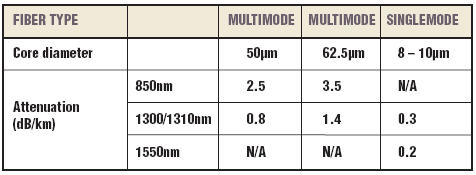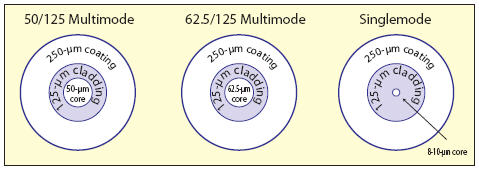- In this first series of articles on fiber optic facts and applications, we will start with some of the basics of fiber optics—the fiber itself—and discuss some of the fundamental differences between multimode (MM) and singlemode (SM) fiber.
- Of all the differences between MM and SM fiber, the most fundamental differences are the size of the fiber’s core and the associated attenuation or loss and bandwidth of the fiber. The fiber itself consists of three basic portions—the core, cladding, and buffer or coating.
Courtesy: The Light Brigade, 2008 The core is the most central portion of the fiber where the light travels.
There are three basic fiber core diameter sizes. SM fiber has a core diameter of nominally 9 micrometers while multimode fiber has either a 50-micrometer or 62.5-micrometer core diameter. For the fibers we use, the cladding is always 125 micrometers while the protective coating has a diameter of 250 micrometers. Other buffers and jacketing materials help build the fiber up to more practical and rugged cable structures.
The basic rule of thumb is that the smaller the core diameter, the higher the fiber’s bandwidth and the lower the attenuation (loss in dB per kilometer). The fiber’s attenuation and bandwidth are also dependent on wavelength. The table on this page illustrates the approximate attenuation of both MM and SM fibers.
As we later explore the characteristics of these fibers, we will show that systems will be either loss or bandwidth limited. The fiber will either attenuate the optical signal to such a point where the receiver cannot reliably recover the information or the bandwidth of the fiber will distort the signal to where it cannot be recovered even though there is plenty of optical signal at the receiver.

Due to its industry familiarity and relatively large core size, MM fiber is currently the accepted fiber for many installations, particularly in environmentally hostile locations such as outdoors, dirty/dusty floors, etc. The large core of MM fiber is more tolerant to dust and dirt at the optical connectors. Small specs of dust can easily block the entire core of a SM fiber, resulting in significantly higher connector attenuation.
In addition, it is somewhat easier to terminate MM fiber on connectors in the field. However, the bandwidth limitations of MM fiber can severely limit the transmission distance of high bandwidth video signals. Fiber attenuation is one of the basic characteristics of fiber that needs to be understood and taken into consideration when designing any fiber transmission system.
As we continue to explore the characteristics of MM and SM fiber, we will show that the maximum distance of MM fiber will typically be limited by the bandwidth of the transmitted signal while the maximum distance of SM fiber will be limited by the attenuation of the fiber or the loss budget of the fiber transmission equipment.
Our next topic will discuss the bandwidth issues of fiber and highlight the characteristics of each and how it affects video performance as a function of fiber type and distance.
